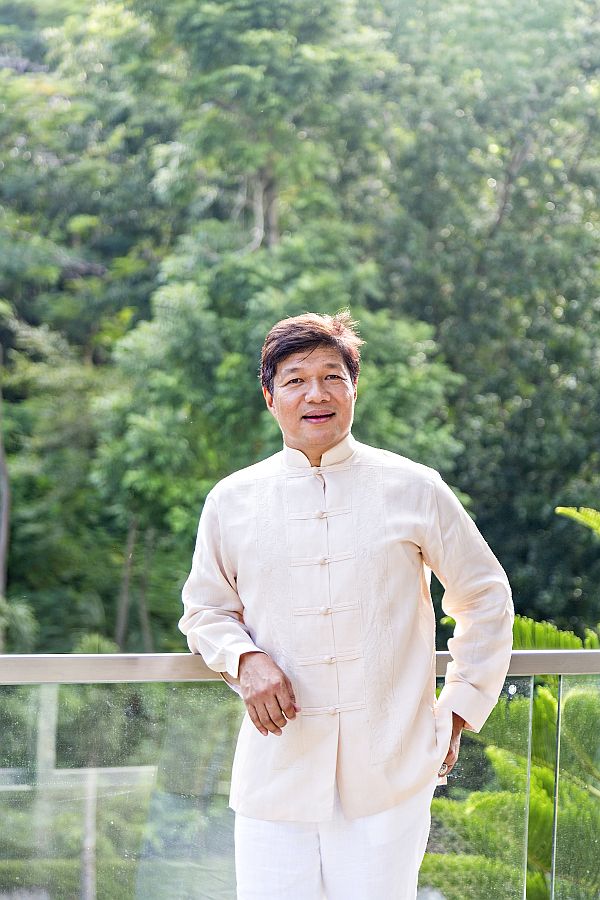
Architect James Jao
A QUICK search on the Internet for Philippine eco-architecture yields top-of-the-page results on architect and interior designer James Galias Jao, a Bicolano educated in Manila (University of Santo Tomas) and living—and practising—in Cebu for some 30 years.
Cebu was his city of choice after graduation to practice his profession and he has no regrets. Being Cebu-based and fluent in Sugbuanon
Cebuano has enabled him to create clientele throughout the Visayas and Mindanao.
In a roundabout manner, he is being noticed in Manila and the rest of Luzon, thanks to favorable media coverage there.
Recent features in Asian Dragon Magazine, Philippines Tatler Homes Volume 13 (on his critically-acclaimed “Kite House”), and Metro Homes (on his First Eco House in Ayala Alabang) have built his reputation on a national level.
He even made cover on Business + Class Magazine at the wake of television interviews—in “Rated K” and “Green Living”—beamed nationwide.
His resume reads, thusly: “For being a leader in eco-architecture and sustainable development, he was elevated as Fellow by the United Architects of the Philippines in 2013.
He is the immediate past National President and now the Chairman of the Philippine Institute of Interior Design for the 2017-19.
He is also the Deputy President of the Asia Pacific Space Designers Association 2017-19.”
Architect Jao attended the London School of Economics, earning a Master’s of Science Degree in City Design and Social Science, in 2005; and upon his return he built his ground-breaking full-scale models that he baptized as “Eco-house”.
These liveable spaces were exhibited at the SM Mall of Asia and made the front page of the Philippine Daily Inquirer. That practically launched his niche and shaped his present reputation.
“Since then, he has been actively designing projects that fuse modern aesthetics, climate-resistant strategies, and green materials and methods of construction (from residential works to master planned communities) and spreading his design and architectural philosophy in the Philippines, China, Singapore, Indonesia, Malaysia, South Korea, South Africa, Australia, and United Kingdom, among others” writes his friend and Palanca-awardee Carlo Daoana of Architect Jao.
Getting published
Despite the advent of e-magazines and similarly formatted publications, the respectability of hardcopy print continues and serves as a complementary anchor to digital media.
Getting published in hard print still matters opined Architect Jao. He believes the print media is still very relevant. So how does he manage to get his architecture and design projects see print?
Based on his experience, Architect Jao gives some tips and his thoughts on the matter:
1. Projects with “Big Idea” gets the nod of editors.
A unique, out-of-the box and cutting-edge design is a good way to stir the attention
of readers.
It doesn’t always need to be a big budget, large development, or high-rise project.
“It can be a small project, low budget in a remote area, but if the design value is there, coupled with the “big idea” then you are in for a feature in a magazine.”
2. Professional photography is a big help.
“Nowadays, iPhone takes very good snap shots of projects both from the exterior and interiors.
But it is best to engage the services of professional photographers in your city, and maybe you being the architect or designer can even suggest the best angle that can tell a better story of your project and always take snap shots of ’work in progress’, they are sometimes essential to a better understanding of the design process.”
3. For architectural designs, particularly in residential projects, Architect Jao strongly suggests one to engage the services of licensed interior designers.
“I have seen a lot of good architectural designed residential projects but very weak when it comes to interiors if they themselves tried to do the interiors themselves. These projects eventually get turned down by editors since the interiors have no clear cut styling at all. There are few talents in the professional arena, of multi-faceted practitioners who are both architect and interior designers.”
4. Self-publish and use social media.
“With the advent widening of social media and digital communications, having your own FB page or
Instagram account for your projects will be very helpful and this may lead to the attention of the editors. The social media has become an avenue for finding noteworthy projects and new talents in the design world”.
5. Share your expertise and opinions.
“From prevailing issues or design trends it pays to write articles to give some pointers from home renovations, color trends and applications, space planning to a more sustainable design approach from recycling to up-cycling. If you have talent in creative writing, write articles on different design styles and space solutions. For those with postgraduate degrees, you can start from urban planning, to addressing environmental issues, historical preservation and conservation, and urban gentrifications”.
6. Join design competitions.
In the international scene, mostly if not all projects are awarded through competitions.
In the Philippines, there are projects that invite shortlisted firms for a design pitch or eventually a brief for a competition. “Winning a competition is a story by itself especially if the project is of utmost significance. From the competition process to the awarding, design development, project work in progress and eventually project completion, these are very interesting part of the whole story. From the design brief to set of challenges encountered during the construction and last minute design interventions, it is worth telling the story.”
In all these be original, exhorts architect James Jao.
“Always have the confidence to create your own design based from your own design philosophy and concept. Also never be repetitive in your design, or you end up being redundant.”
* * *
Architect and interior designer James Jao lectures tomorrow, Aug. 26, at the Sarrosa International Hotel, F. Cabahug Street, Cebu City on the topic.)
